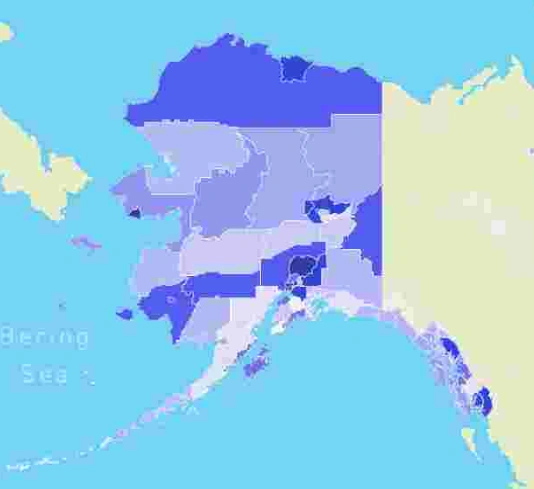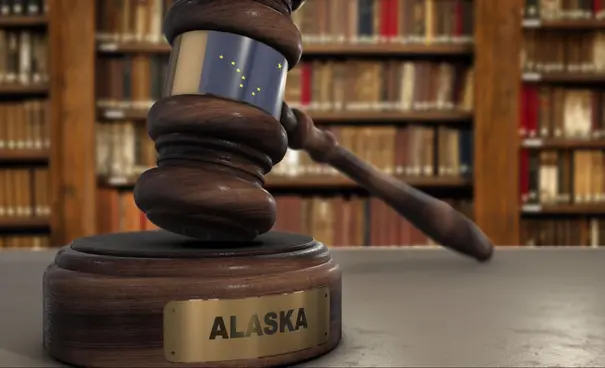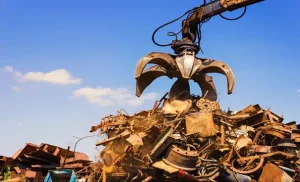Alaska. Land of glaciers, moose, and… surprisingly high crime stats. Travelers, new residents, and even Alaskans themselves want to know: what’s going on?
We conducted extensive research using reliable sources to provide you with the latest 2025 statistics, including sifting through reports from the Alaska Police Department and the FBI, opinions from legal experts, and information from residents.
We provide you with the safest neighborhoods and practical tips to help you stay safe in Alaska’s high-risk areas. Let’s stroll through: the numbers, the root causes, what experts say, and how businesses can stay safer in Alaska.
Alaska crime map:

We can see in the image that the darker shaded regions mark Alaska’s most crime-prone areas, while the lighter regions signal safer ground.
The northern part of the state bears the heaviest burden, with some of the highest crime-ridden neighborhoods. The center of Alaska, by contrast, exhibits relatively calm pockets, although challenges remain.
In the south, especially around Anchorage and nearby towns, property crimes and violent incidents cluster, from rising vehicle thefts to steady high rates of assaults. The murder rate in Alaska is among the highest in the country, mainly concentrated in urban areas.
Crime stats in Alaska:

Fresh data from the FBI Uniform Crime Report mirrors the larger picture: more than 19,000 crimes in a year, with violent crime at 7.26 per 1,000 residents. That`s nearly double the national average.
Why is crime so high in Alaska?
FBI crime data, state reports, and local news investigations uncover that Alaska continues to rank among the nation’s most crime-heavy states because of:
Geography:
Alaska’s geographical location is a significant reason why crime rates are higher here than in almost any other place. When your town is only reachable by plane or boat, calling 911 doesn’t mean help is minutes away; it could be hours, even days.
Harsh winters and endless nights lock people in, storms cut communities off, and isolation feeds frustration, substance abuse, and conflict. Cities like Anchorage feel it in numbers, but in the villages, it’s personal: no police nearby, no shelter within reach, no quick way out. Geography doesn’t just shape the land in Alaska; it shapes how crime unfolds, turning distance into danger.
Socioeconomic factors:
Alaska’s crime rate can’t be separated from the socioeconomic reality on the ground. The people living in Anchorage see homelessness and theft rise when jobs disappear.
Data backs this up. In early 2025, Anchorage was the only U.S. metro to see vehicle thefts climb, up 26% statewide. Police made progress in April and May, with a 30% drop, but year-to-date numbers were still nearly double those of prior years. And it isn’t just cars. Thieves have stripped copper from more than half of Anchorage’s utility substations since last fall, cutting into live wires and putting entire neighborhoods at risk.
Culture and history:
In bigger cities like Anchorage and Fairbanks, aggravated assault rates have surged up over 60% in the last few years, leaving Alaska’s violent crime rate several times higher than the U.S. average.
At its core, this isn’t only about money or distance; it’s about wounds carried forward through generations.
Substance abuse:
Substance abuse sits at the heart of Alaska’s crime problem. In a place where long winters bring isolation and endless nights, alcohol and drugs often become an escape.
Then there’s the issue of guns. Alaska ranks 2nd in the nation for overall gun violence. In 2023, 176 people died from gun-related injuries, about 47 homicides and 120 suicides, with deaths per 100,000 well above the national average.
Schools in Anchorage are now implementing the use of random metal detectors in middle and high schools. Proposals to fine parents if kids bring guns to school or to require stolen firearms to be reported within 48 hours were debated but rejected.
What state and law enforcement reports are saying about Alaska crime?
We went straight to the source: state reports, police releases, and criminal justice analyses. The Alaska Criminal Justice Data Analysis Commission’s 2024 Annual Report confirms one stark truth: property crime has dropped dramatically since 1985 by more than 60% yet violent crime has held nearly flat, largely driven by assaults.
The Alaska Department of Public Safety’s 2024 Annual Report highlights that Alaska faces some of the highest rates of domestic violence and sexual assault in the U.S. It also notes efforts underway to improve forensic tools in remote communities so evidence collection can happen faster.
The Anchorage Police Department’s internal review shows that over the past 15 years, officer-involved shootings have increased, prompting updates to its “Use of Force” dashboard.
And even local crime trends reflect the tension: in downtown Anchorage, assault calls decreased in early 2025 compared with the same period in 2024, from 102 to 161 calls, possibly hinting at shifting patterns or a change in police focus.
Top 5 high-crime neighborhoods in Alaska for families:
We have pulled the top crime spots in Alaska from local police dashboards, neighborhood crime maps, and recent reporting. And we bring you the five most crime-targeted neighborhoods of Alaska:
1. Fairview (Anchorage):
It was singled out as Anchorage’s most troubled neighborhood. CrimeGrade projects a crime rate of 52 per 1,000 residents and gives Fairview one of the highest violent crime scores in the city.
2. Mountain view (Anchorage):
It has been a persistent hot spot for assaults, shootings, and serious incidents. Crime maps show a violent crime rate of around 12.6 per 1,000 in parts of the neighborhood and frequent APD responses and homicide/shooting investigations in 2024–2025.
3. Spenard (Anchorage):
It’s a densely populated mix of housing and nightlife areas, with high property and violent crime rates in some areas. Local news lists Spenard with a crime rate of 59.5 per 1,000, and local reporting shows repeated shooting and robbery incidents.
4. Downtown Fairbanks:
Fairbanks as a whole posts very high property crime and auto theft rates; police bulletins and NeighborhoodScout flag a high chance of property crime (about 1 in 25) around downtown commercial strips.
5. Mendenhall valley/parts of Juneau:
Within Juneau, the Mendenhall Valley area often appears on crime maps as a higher-incident pocket compared with other Juneau neighborhoods; local crime mapping and CrimeGrade mark it as an area to watch for thefts and assaults.
Top 5 safest cities in Alaska:
Although Alaska struggles with some of the nation’s highest crime rates, a few towns stand out for their exceptional safety. The FBI and local reports show that Haines, Wrangell, Cordova, Valdez, and Seward consistently rank as the safest cities in Alaska, and here’s why.
- Low violent crime: Haines posts only 49 violent crimes per 100,000 residents. Currently, Haines is ranked as the safest city in Alaska, thanks to its very low violent crime rate.
While Wrangell reported just one violent crime in recent years, Seward, with nearly 3,000 residents, had only six violent crimes in a year. - Small, close-knit populations: With fewer than 5,000 residents each, these towns benefit from tight community ties and more informal oversight, fewer strangers, and more accountability.
- Less nightlife, less crime: Limited bars and commercial strips mean fewer hotspots for theft, assault, or late-night incidents.
How does Remote Video Monitoring help businesses stay safer in 2025?
Alaska’s wilderness may be vast, but so are the risks. Behind the beauty lies one of the deadliest realities in America: guns take more Alaskan lives than car crashes.
That’s where AI-powered video analytics steps in. These aren’t just CCTV cameras recording footage; they’re intelligent systems that recognize threats the moment they appear.
Gun detection:
Gun detection AI cameras can spot firearms on-site within seconds, sending verified alerts to monitoring teams and law enforcement. In a state where violent crime rates are nearly four times the national average, that kind of early warning can mean the difference between prevention and tragedy.
Intrusion detection:
Alaska businesses often operate in isolated areas where patrols can’t respond quickly, making intrusion detection vital. Intelligent video analytics detect unusual movement, perimeter breaches, or unauthorized access, stopping copper theft at utility sites or equipment theft on construction sites before the damage is done.
Violence detection:
From bar fights in Anchorage to assaults in remote villages, Alaska’s aggravated assault rate remains one of the nation’s highest, making violence detection crucial. Video analytics can flag sudden aggressive movements, physical altercations, or escalating situations in real time, allowing security teams to intervene quickly.
Frequently asked questions:
Which 10 cities have the highest crime rate?
Nationally, cities like St. Louis, Detroit, Baltimore, Memphis, Cleveland, Birmingham, Milwaukee, Kansas City, Stockton, and Oakland rank among the highest for crime rates.
What is Alaska ranked in terms of crime?
The most common crime in Alaska is gun violence. Alaska is ranked 2nd in the U.S. for violent crime and near the top for gun violence.
Conclusion:
So, does Alaska have the highest crime rate? Yes, it regularly ranks first among all U.S. states for both violent and property crime.
Alaska’s elevated crime rate can’t be blamed on a single factor. Experts point to isolation, harsh geography, limited law enforcement access, economic turbulence, cultural heritage, and drug addiction.
FBI statistics attest that violent crime is almost twice the national average, and Anchorage and Fairbanks dominate with assaults, thefts, and property offenses.
But hope exists in Alaska! There are still some towns that remain among the safest in the U.S., and companies are increasingly resorting to remote video monitoring and AI detection to gain an edge against danger.
Contact us today for customized security solutions for your business in Alaska or the surrounding areas.





